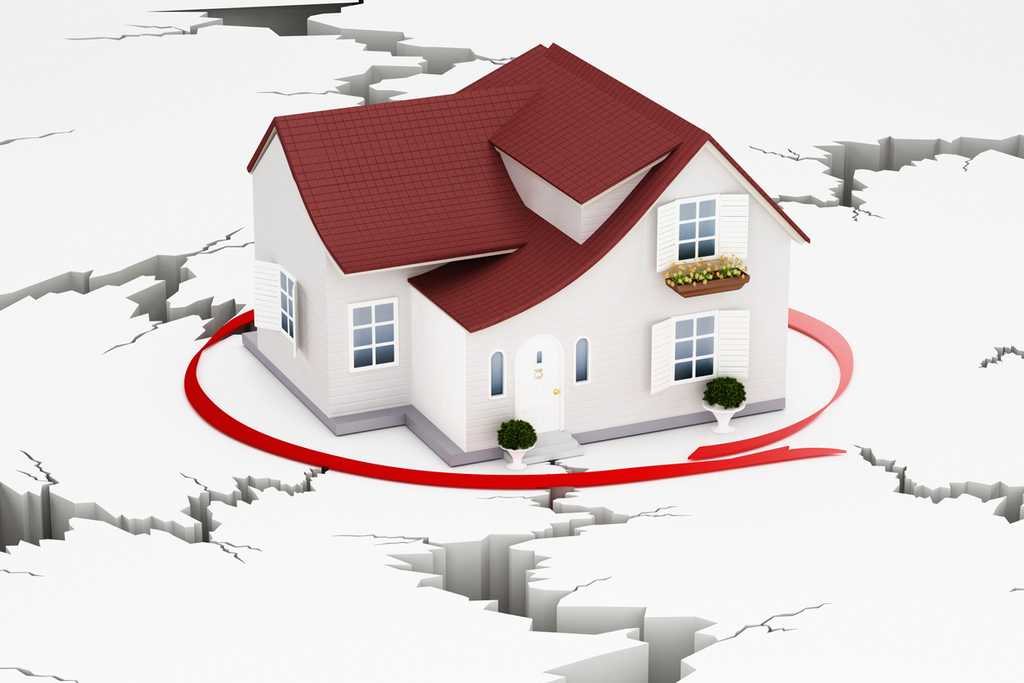Earthquake insurance is available to homeowners who are concerned about the potential for quake damage. If your home and/or personal belongings are damaged or destroyed as the direct result of an earthquake, this insurance will help pay the cost to repair or replace your property. It will also help pay the cost of temporary housing while your home is repaired or rebuilt. You’re required to pay a deductible, which is your share of those costs.
Depending on the company, earthquake insurance may be added to a homeowners policy as a rider (optional add-on), or it may be available as an additional, separate policy. It’s important to note that a standard homeowners policy does not provide coverage for earthquake damage. Earthquake insurance thus acts as a supplement, helping provide complete coverage for your home.
What earthquake insurance covers
Earthquake insurance consists of three main coverages. Each is designed to reimburse you for expenses related to earthquake damage.
Dwelling
Reimburses you for the cost to repair or rebuild your home if it’s damaged by an earthquake. Your earthquake dwelling coverage limit (the maximum amount the insurance company will pay for a claim) is typically set at the same level as your homeowners policy dwelling coverage limit. Your insurance company may also offer a rider that ensures it covers the full cost to rebuild your home to be in compliance with current building codes (this can add significantly to the rebuild cost).
Dwelling coverage is also subject to a deductible — your share of the cost to repair or replace your property if you file a claim. Earthquake policies typically have a deductible that’s between 2% and 20% of the coverage limit, according to the Insurance Information Institute. So, if you have a dwelling limit of $200,000 with a 15% deductible, your “share” of the cost to repair/rebuild your home will be $30,000.
Personal Property
Reimburses you for the cost to replace personal items (such as furniture, electronics, appliances) damaged or destroyed by an earthquake. This coverage usually has a set-dollar-amount limit. It can be as low as $5,000 but can be increased for additional premium.
Loss of Use
Reimburses you for the cost of extra, temporary expenses if you need to live somewhere else while your home is being rebuilt or repaired. This not only includes the cost of a hotel or temporary apartment but may include reimbursement for meals and laundry services. Again, this coverage typically has a set limit, sometimes as low as $1,500. You can usually get a higher limit for additional premium.
It’s important to note that earthquake policies exclude (do not provide coverage for) a variety of items. These include damage to your vehicles, fence, pool, and landscaping.
The fact is, if your property is damaged by an earthquake, you may end up filing a variety of insurance claims (each with its own deductible). Any damage to your home that’s directly attributed to the quake will be covered by your earthquake insurance. Damage to your car will be covered by your auto insurance policy’s comprehensive coverage. If you live on a coast and the quake causes a tsunami that damages your home, you’ll need to file a flood insurance claim. If the earthquake causes a fire that damages your home, you’ll need to file a homeowners insurance claim.
What earthquake insurance costs
The cost of earthquake insurance is influenced by a range of factors. The likelihood of your geographical region experiencing an earthquake is foremost. The age of your home, its number of stories, the type of material used in its construction, and its foundation materials all factor into the premium.
Earthquake insurance can be costly, particularly for those who live in earthquake-prone regions such as California and the Pacific Northwest.
According to the Insurance Information Institute, a policy for a wood-frame house in the Pacific Northwest could cost up to $3 per $1,000 worth of coverage annually. For a $300,000 house, that’s $900. A policy for the same house on the East Coast might cost just 50 cents per $1,000 of coverage, or $150 annually.
Earthquake insurance in California
California is the country’s most active state for earthquakes. There are more than 500 active faults in the state, and most Californians live within 30 miles of at least one of them. Scientists predict there’s a 51 percent chance that San Francisco will experience one or more 7.0 magnitude quakes between 2014 and 2044.
Earthquakes simply are a fact of life in California. For that reason, earthquake insurance can be very expensive for homeowners in the state. Many Californians buy their earthquake insurance through the California Earthquake Authority (CEA).
Formed in the years following the 1994 Northridge earthquake near Los Angeles, CEA is a not-for-profit entity that helps Californians get coverage from 25 participating insurers. The organization helps insurers offer competitive premiums, and helps homeowners earn discounts through risk mitigation practices, such as improving their homes to be more resistant to quake damage.
Is earthquake insurance worth it?
While earthquakes are usually thought of as a problem for the West Coast, the fact is that 42 U.S. states are at some risk for earthquakes. Sixteen states are considered “high risk,” including Alaska, California, Hawaii, Idaho, Kentucky, Missouri, Montana, Oregon, South Carolina, Tennessee, Washington, and Wyoming. So the risk does indeed extend beyond places such as California and the Pacific Northwest. Damage-causing quakes have been recorded in states with lower risk.
The United States Geological Survey suggests homeowners think through a variety of factors when considering whether to buy earthquake insurance. These can be summarized as follows:
- The seismic history of your home’s area, and its proximity to active faults
- The ability of your home to withstand an earthquake, based on its specific location, design, and construction
- Your ability to cover the likely cost of earthquake damage to your home
Compounding these factors is the cost of insurance itself. This cost includes the policy’s deductibles, which are usually much higher than those for homeowners insurance. For that reason, it often makes sense to only file a claim for very severe earthquake damage.
For instance, let’s say you have a policy with a 15% deductible and a dwelling limit of $300,000. An earthquake causes damage to your home that will cost $40,000 to repair. Your deductible — your share of the cost to repair — is $45,000. It won’t even make sense to file a claim. You might wonder why you have the policy at all.
Of course, policies with lower deductibles are likely available, but at a much higher premium.
So if you live in an area that’s at a lower risk for earthquakes, particularly major ones that could cause severe and widespread property damage, then it’s understandable to be skeptical about the need for coverage. You might want to have a conversation with a licensed insurance agent, who should have a good understanding of the potential risks for your property and geographic area.
Where to get earthquake insurance
If you crunch the numbers, assess your risk, and decide that earthquake insurance is a smart idea, then start with your homeowners insurance company. Chances are it provides earthquake coverage either as an add-on to your homeowners policy or as a separate policy.
In California, you can buy coverage through the CEA and its 25 participating companies.
Aside from these resources, you can contact an insurance agent or shop around between companies to find the best combination of coverage and cost for you.
Conclusion
Earthquake insurance goes above and beyond a standard homeowners policy, covering damage to your home that’s a direct result of a quake. The cost of these policies, including their deductibles, are high. But if you live in a region that’s at risk for earthquakes, or are concerned about your ability to pay out of pocket for damage to your home, earthquake insurance may be something you want to consider carefully.
Frequently asked questions
Does homeowners insurance cover earthquakes?
No, a standard homeowners insurance policy does not provide coverage for earthquakes. Earthquake insurance is available either as a rider (optional add-on) to a standard homeowners policy, or as a separate policy.
Does business insurance cover earthquakes?
No, standard business insurance does not provide coverage for earthquakes. Ask your insurer about your options for adding earthquake coverage to your business insurance portfolio.
Why are earthquake insurance deductibles so high?
Insurers have to price their policies to reflect the financial risks associated with what they’re insuring; otherwise, they wouldn’t have enough money to pay their claims. For earthquake insurance, the severe financial risks involved result in higher premiums and higher deductibles than standard homeowners insurance.
From almost any perspective, the financial impact of a severe earthquake can be catastrophic. According to NBC News, the 1994 Northridge quake in California resulted in $12 billion in insured losses. If the 1906 San Francisco earthquake had happened today, it’s estimated it would cause more than $100 billion worth of insured losses!
Do I need earthquake insurance as a renter?
Similar to a standard homeowners policy, a standard renters policy will not provide coverage for earthquake damage. However, earthquake insurance is available for people who rent their homes. Contact your renters insurance company or insurance agent to learn more about how you can get this coverage.

